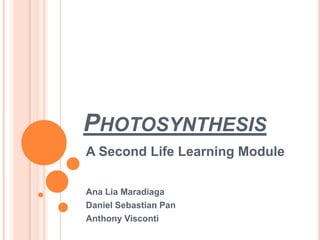
Cs 417 Photosynthesis
- 1. Photosynthesis A Second Life Learning Module Ana Lia Maradiaga Daniel Sebastian Pan Anthony Visconti
- 2. RATIONALE
- 3. Choosing topic, media, & Learning Approach: All of these choices were based on our initial choice of intended audience. The selected intended audience were elementary students. TOPIC: We had a common interest in science, and decided to explore energy. It was narrowed down to photosynthesis. Photosynthesis for elementary students is basically focused on the overall process and viewed as the plant’s food. We decided to prepare resources to enrich a classroom lesson on photosynthesis.
- 4. Choosing topic, media, & Learning Approach: MEDIA: Photosynthesis is presented in fourth grade in the science curriculum, our project had to be developed to be used in a 4th grade classroom. We decided to use Second Life and create a Photosynthesis Corner. The corner serves as a virtual field trip for the students because they are visiting another world. The corner would have resources for the teachers and serve as a tool to develop a multimedia enriched lesson.
- 5. Choosing topic, media, & Learning Approach: LEARNING APPROACH: We envision the photosynthesis corner to be a teaching-learning tool rather then the lesson itself. Through the exploration of the resources provided, the teacher and the student will make meaning together and construct their own knowledge. Although it is suggested the narrative guidance should be included in the software design (or site in our case), we decided to trust the teacher with most of the narrative guidance. (CH 3 - Cognition, Education and Communication Technology) Following a constructivist point of view, we suggest teachers to introduce the topic by relating photosynthesis to the students’ past experiences and through analogical reasoning map their own need for food with the process of photosynthesis and the plants’ needs.
- 6. Choosing topic, media, & Learning Approach: The interactivity with the student may only be one way with the videos and diagrams, but in a classroom setting though, they should be watched and discussed, supporting collaborative learning. The concept map is a great way to model connections between elements and supports the construction of a holistic view of photosynthesis and energy. This element not only helps the student on an individual level as we have just described, it can also be used to initiate discussions and assess students’ understanding. The games are included as a way for students to interact individually with photosynthesis and its main components. These reflect more of a behaviorist point of view, reinforcing the participating elements of photosynthesis.
- 7. SITE CONTENT
- 8. Site Areas: The site is divided into 3 sub-areas according to its content intended use: Teachers: contains objectives, suggested introduction to the topic and extra resources. Students: To aid in their learning two diagrams, videos, a concept map, interesting facts and small games were included. Enrichment: Contains videos with advance information that could either be for students or as a sources for in-depth content knowledge for the teachers.
- 9. The Second Life Environment
- 11. Identify photosynthesis as an activity of plants that allows them to survive.
- 13. Videos to share in the Classroom: Narrated Video: A Plant Story http://www.youtube.com/watch?v=CXbhdBzx1Ag&feature=related Main themes: germination and photosynthesis, it describes how a plant begins, germinates grows and then how it stays alive thanks to photosynthesis. Source: youtube.com, time: 2:59 min K-Science Animations: Photosynthesis http://www.kscience.co.uk/animations/photosynthesis.htm Main themes: photosynthesis from a microscopic view, the process taking place in the chloroplasts inside the plant cell. Photosynthesis http://www.youtube.com/watch?v=mpPwmvtDjWw&feature=player_embedded#! Main themes: photosynthesis, this video is excellent; it gives a very good description of the process but uses several technical terms. It is more for middle school kids than fourth graders.
- 14. Did you know? Some interesting facts about plants, energy and photosynthesis: In many tropical areas of the world there are huge forests. These are often known as the 'lungs of the world' because they produce oxygen. These forests are really important because they reduce the amount of carbon dioxide in the air. This is a gas that is increasing because of industrial pollution. It is thought to be creating a 'greenhouse' in the sky that heats up the planet and changes the weather. BBC.co.uk Millions of years ago, the sun's energy helped prehistoric plants to grow. When we burn coal we are reusing that ancient sun-energy, because coal is made from prehistoric trees. BBC.co.uk